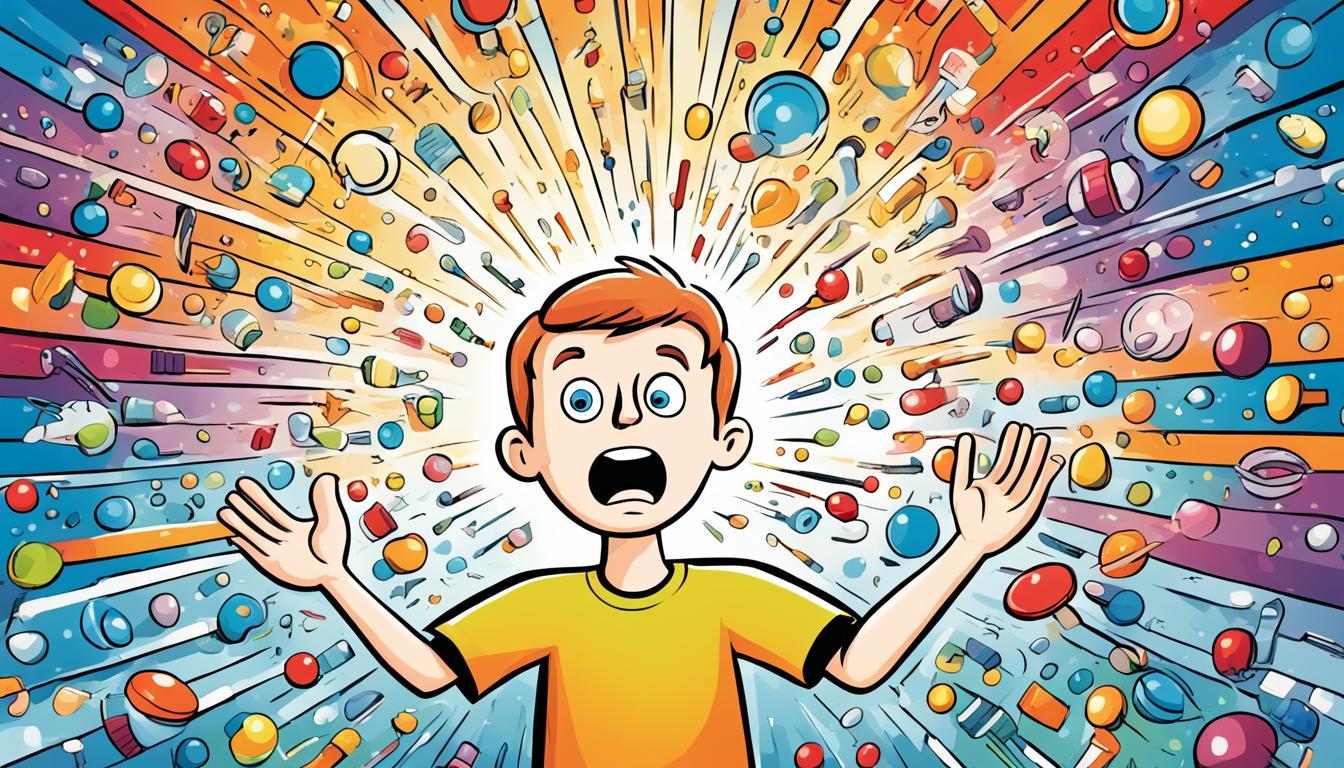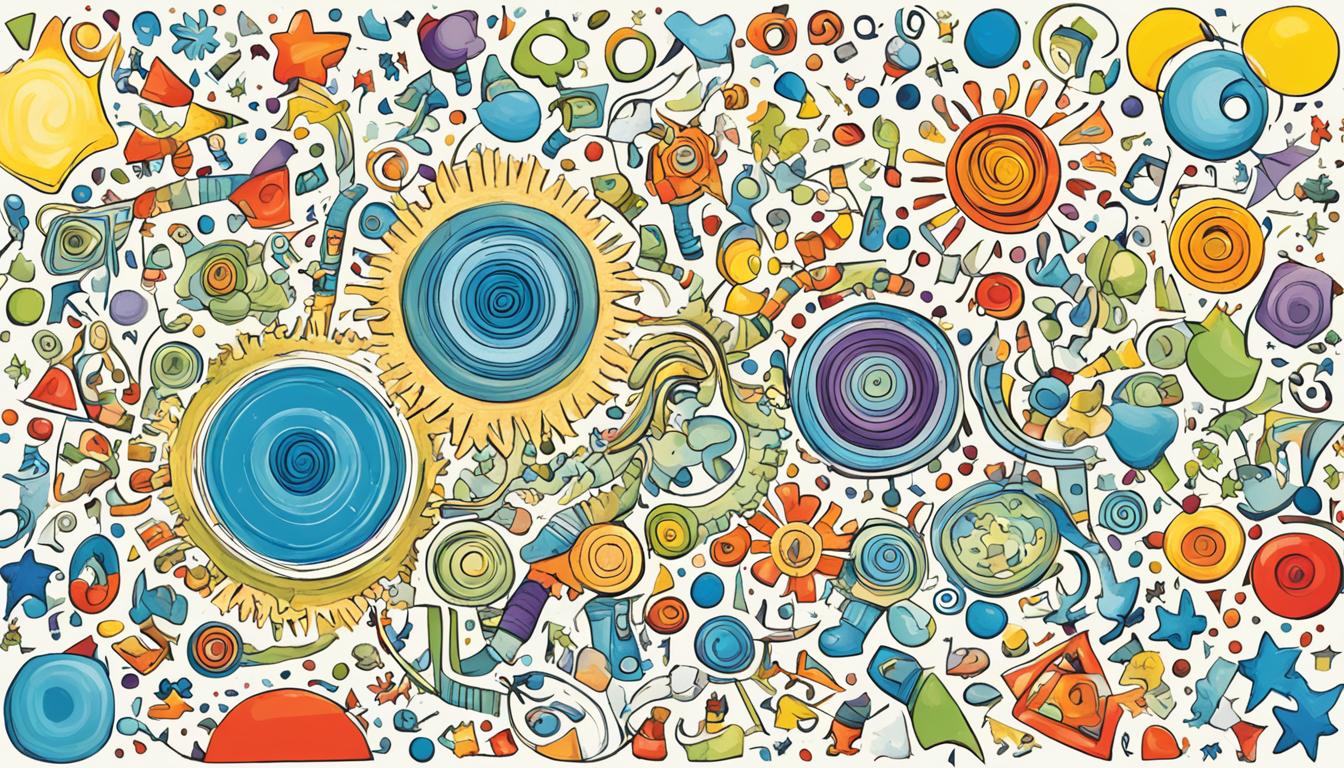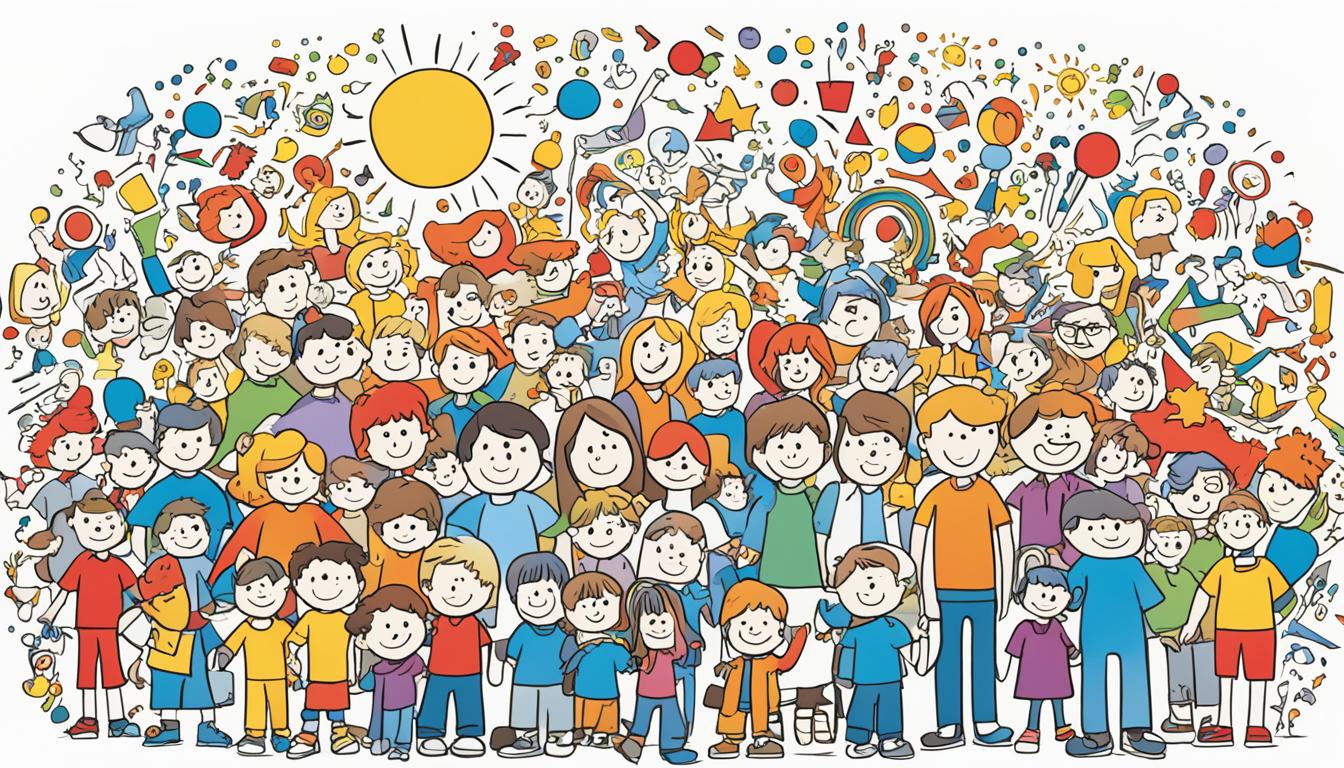Music therapy is a powerful way to help children with autism spectrum disorder (ASD). It uses music to tackle many challenges faced by kids with ASD. This includes helping with behavior, social skills, and more.
Studies show music therapy works better than other treatments for kids with ASD. It helps them connect with others and improve how they communicate. This is especially true for kids with autism spectrum disorder.
Music therapy includes activities like singing and playing instruments. It helps kids with ASD talk better, feel their emotions, and make friends. It also boosts their confidence and makes them feel better about themselves.
Table of Contents
ToggleUnderstanding Autism Spectrum Disorder
Autism Spectrum Disorder (ASD) is a complex condition. It affects how people interact and communicate. It also impacts their behavior and emotions.
Those with ASD might find it hard to talk or understand others. They may struggle to fit in socially and control their feelings. The symptoms of ASD vary from person to person.
Definition and Characteristics
ASD is a lifelong condition, says the American Psychiatric Association. It affects how people communicate and interact with others. It also affects their behavior and interests.
These symptoms can be mild or severe. They often show up in early childhood.
Prevalence and Impact on Families
Autism is common, with 1 in 54 children in the U.S. diagnosed in 2020. It has a big impact on families. The challenges of ASD can change daily life a lot.
Early help and support are key. They help individuals with ASD and their families deal with these challenges.
The Role of Music Therapy
Music therapy is key for kids with autism spectrum disorder (ASD). It uses music to help them talk, express themselves, and grow. It makes a safe space for kids with ASD to do well.
What is Music Therapy?
Music therapy uses music to help with ASD challenges. Music therapists set goals and create plans for each child. They work with the child, family, and others to use these plans in daily life.
Techniques Used in Music Therapy
- Behavioral techniques: Using music to shape and reinforce desired behaviors.
- Biomedical techniques: Incorporating music to address sensory processing and regulation.
- Developmental techniques: Utilizing music to foster cognitive, social, and emotional growth.
- Educational techniques: Adapting music instruction to meet the child’s unique learning needs.
- Humanistic techniques: Employing music to promote self-expression and emotional well-being.
- Adaptive techniques: Modifying musical activities to accommodate the child’s abilities and preferences.
Music therapists use many techniques to build a strong bond with the child. This creates a supportive space for their growth and development.
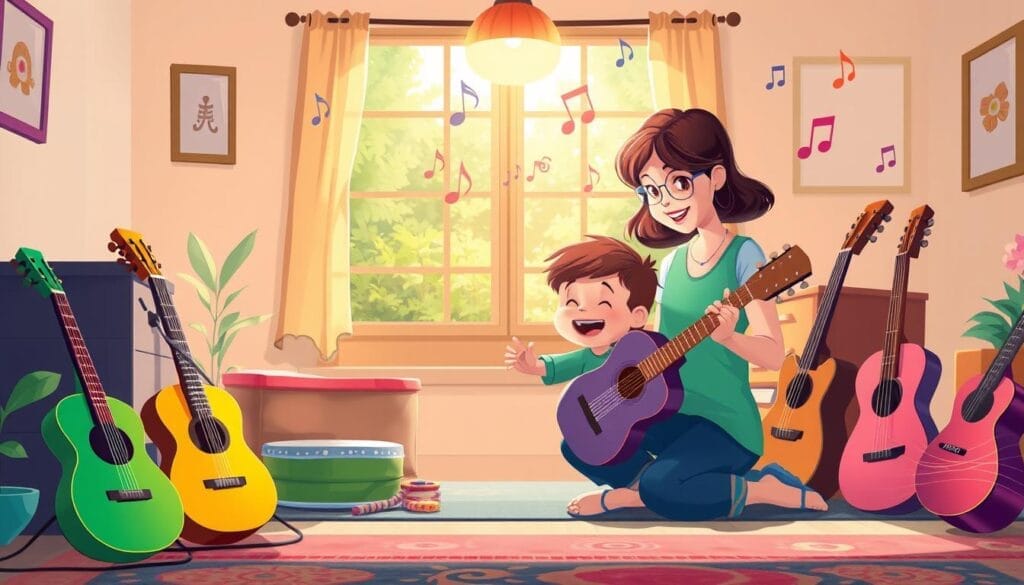
How Music Therapy Enhances Communication Skills
Music therapy is a powerful tool for kids with Autism Spectrum Disorder (ASD). It helps improve their communication skills. This therapy uses music to help kids express themselves and connect with others.
Nonverbal Communication
Many kids with ASD struggle to talk. Music therapy gives them a way to express themselves without words. Through music, they can show their feelings and needs with body language and gestures.
Turn-Taking and Interaction
Music therapy helps kids with ASD learn important social skills. They practice taking turns and listening in music activities. This helps them become better at socializing and making friends.
Studies show music therapy boosts verbal skills and non-verbal communication in kids with ASD. It helps them connect with others and express themselves better. This way, music therapy makes a big difference in how kids with ASD communicate and interact.
Emotional and Behavioral Benefits
Music therapy helps kids with autism spectrum disorder (ASD) a lot. It lets them better understand and share their feelings. This can make them feel less upset and less likely to act out.
Reducing Anxiety and Stress
Kids with ASD often feel anxious and stressed. Music therapy is better than other treatments at lowering these feelings. Music makes them feel calm and relaxed, helping them handle their emotions better.
Promoting Positive Behavior
Music therapy also helps kids with ASD behave better. It lets them share their feelings in a good way. This helps them feel happy and more connected with others.

Music therapy is great for kids with ASD. It helps them feel less anxious and stressed. It also helps them behave better and feel more positive.
Social Skills Development
Music therapy is key in helping kids with Autism Spectrum Disorder (ASD) improve their social skills. It helps them get along better with others through group music activities. This makes it easier for them to make friends and feel part of a group.
Building Relationships
Music therapy sessions are often in groups. This lets kids with ASD work together on music projects. They learn to share, communicate without words, and feel like they belong.
The music therapy is structured and easy to follow. This makes kids with ASD feel more at ease around others. They start to get better at making friends and building relationships.
Group Music Activities
Playing instruments, singing, or doing rhythmic exercises together is great for kids with ASD. These activities help them interact with others, work together, and improve their communication skills. Making music together is a fun way for them to practice social skills.
Studies show music therapy really helps kids with ASD. It boosts their social skills, focus, and coordination. Music therapy helps kids with ASD adapt socially, interact better with peers, and build strong relationships.
Cognitive Improvements Associated with Music Therapy
Music therapy can help improve thinking skills in people with autism spectrum disorder (ASD). It uses rhythms and melodies to engage the brain. This can make it easier for kids with autism to focus and pay attention.
Enhancing Attention and Focus
The beat in music helps organize the senses of those with ASD. This leads to better hearing and other skills. It also helps with staying focused, which is key for learning.
Memory and Learning Benefits
Research shows music can work with parts of the brain linked to learning and memory. When kids with ASD make music, they can get better at thinking, paying attention, and learning. This is thanks to cognitive functioning, attention span, and learning.
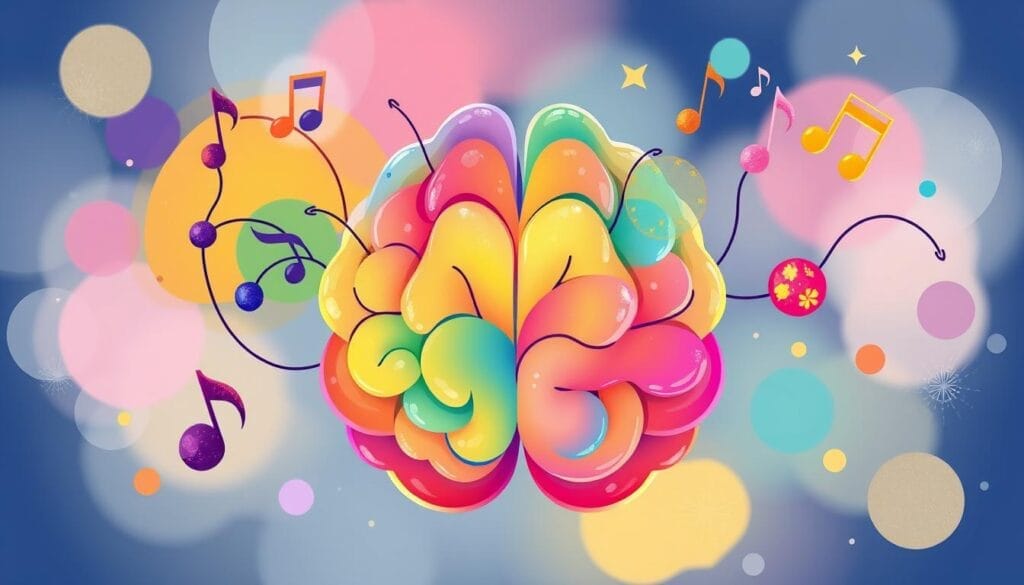
Studies found that using sound therapy early can help kids with ASD learn and respond better. Music therapy gives cues that help kids connect and share experiences. This is important for growing their minds.
Physical Benefits of Music Therapy
Music therapy is a multi-sensory experience that helps children with autism spectrum disorder (ASD) a lot. It uses sounds, sights, touch, and movement to improve their physical skills. This includes fine motor skills and gross motor skills.
Motor Skills Development
Music therapy’s rhythm and structure help kids with ASD improve their coordination and motor control. Activities like playing instruments, dancing, or moving to the beat help them practice and get better. This leads to more independence and better self-care.
Coordination through Rhythm
The rhythmic parts of music therapy are especially good for kids with ASD. Moving to the beat helps them get better at coordinating their movements. This improves their physical skills and body awareness.
Music therapy’s physical benefits for kids with ASD are huge. It helps them become more independent and confident in their bodies. This leads to better well-being and more chances for success in school and social life.
Real-Life Success Stories
Many case studies and testimonials show how music therapy helps kids with autism. These autism success stories talk about big improvements in talking, social skills, and feeling calm. Parents say their child and family’s life gets better with music therapy, showing real music therapy outcomes.
Case Studies of Children Who Thrived
In one classroom, 4 students got music therapy. After a year and a half, the results were amazing. Grace, a student with autism, learned to make sentences with music. Six students, including Grace, will join the 6th-grade choir, showing music therapy’s benefits.
Jimmy, another patient, found a way to express himself and feel better in the hospital. Music therapy helped him walk again after breaking his leg.
Parental Testimonials
Parents share amazing stories of music therapy’s impact. Ms. A’s peaceful passing in a hospice shows music’s role in end-of-life care. Larry’s family talks about how music therapy improved their daily life.

These stories give us a closer look at music therapy’s benefits for autism. The autism success stories and personal experiences from parents and caregivers show music therapy’s power. It makes life better for kids with ASD and their families.
Professional Insights
Music therapy is a key tool for helping kids with autism. It’s backed by science and works well. Music therapists tailor their methods to meet each child’s needs. They use proven techniques to improve communication, social skills, and more.
Perspectives from Music Therapists
Music therapists say music is a big help for kids with autism. They make therapy fit each child’s likes and skills. This way, kids can express themselves, make friends, and feel better.
Research Findings and Evidence
- Research shows music therapy boosts social skills and communication in kids with autism.
- It also helps with thinking and language skills.
- Music helps kids with autism engage and grow, improving how they feel and interact.
- Trained music therapists create plans that really help kids with autism, leading to big improvements.
More research is needed to fully understand music therapy’s benefits for kids with autism. But the early results are very promising.
How to Get Started with Music Therapy
To start music therapy for a child with Autism Spectrum Disorder (ASD), find a qualified music therapist (MT-BC). They have finished an accredited program, passed a national exam, and have 1,200 hours of training.
Finding Qualified Music Therapists
Music therapists work in schools, private practices, or agencies for ASD. To find one, check the American Music Therapy Association (AMTA) directory. You can also ask local healthcare providers, schools, or autism groups for suggestions.
Setting Goals and Expectations
The first step is an assessment of the child’s strengths and needs. The therapist will work with the family to set goals. This might include improving communication, social skills, emotional control, and thinking abilities.
It’s key to have realistic goals and talk openly with the therapist. Some places have funding for music therapy through Medicaid Waivers or private insurance might need approval first.
FAQ
What is music therapy, and how does it benefit children with autism?
Music therapy uses music to help people with autism. It helps with behavior, social skills, and more. It makes life better for those with autism.
What are the characteristics of Autism Spectrum Disorder (ASD)?
ASD makes it hard for people to talk and connect with others. It affects how they communicate and feel. It also makes socializing and controlling emotions tough.
What are the techniques used in music therapy for children with ASD?
Music therapy uses music in special ways. It helps kids grow in a positive way. It uses different music styles to help.
How does music therapy improve communication skills in children with ASD?
Music therapy lets kids without words communicate. It helps them talk and speak better. It also helps them share and listen in their own way.
How does music therapy help with emotional and behavioral regulation in children with ASD?
Music therapy helps kids feel better and act better. It makes them happier and less anxious. It’s better than just sitting there.
How does music therapy improve social skills in children with ASD?
Music therapy helps kids get along better. It makes them more aware of their body. It also helps them focus and move better.
How does music therapy impact cognitive functioning in individuals with ASD?
Music therapy helps kids pay attention better. Music’s rhythm helps their senses work better. It improves how they hear and move.
What are the physical benefits of music therapy for children with ASD?
Music therapy helps kids move better. It improves their fine and gross motor skills. It also helps with coordination and senses.
What do real-life success stories and parental testimonials say about the impact of music therapy on children with ASD?
Many stories show music therapy’s good effects. Parents say it helps with talking, socializing, and feeling better. It makes life better for the whole family.
What should I consider when starting music therapy for a child with ASD?
Find a certified music therapist (MT-BC) first. They assess the child and plan goals. Some places cover music therapy through Medicaid or insurance.
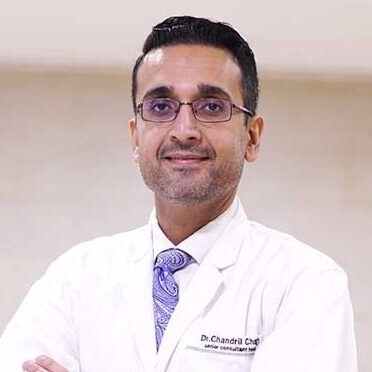
This article is medically reviewed by Dr. Chandril Chugh, Board-Certified Neurologist, providing expert insights and reliable health information.
→ Book a consultation to discover which remedies suit your needs best.
About Author | Instagram | YouTube | Linkedin
Related Blog Posts
Understanding Autism Spectrum Disorder Essentials
April 13, 2024
Understanding Autism Spectrum Disorder Symptoms
April 3, 2024
Understanding Mild Autism Symptoms in Depth
April 3, 2024
Understanding Autism Spectrum Disorder (ASD )
April 3, 2024


